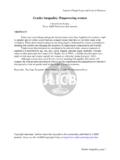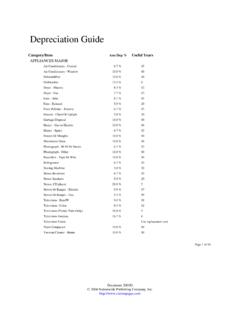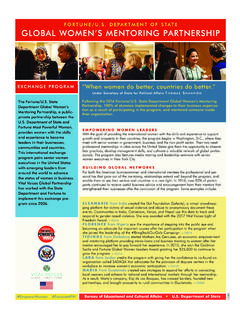Transcription of Gender, Poverty Reduction and Migration - World Bank
1 gender , Poverty Reduction and Migration (Irena Omelaniuk, World Bank). Introduction Why discuss gender and Migration in the context of Poverty Reduction ? Of the 190 million or so migrants in the World today, almost 50% are females; many, possibly the majority having moved from and within developing countries. Of the $160 billion or so migrant remittances sent home to developing countries in 2004 (more than 166 billion in 2005), it is likely that the major proportion was received by women . We know that the integration of a gender perspective into development policies and programs can contribute to their efficacy and sustainability (Ramirez et al, 2005). We also know that Migration , particularly through remittances, can be an important motor for Poverty Reduction and growth in many developing countries (Lucas, 2004; Adams, 2005).
2 But we still know too little about the actual linkages between gender , Migration and Poverty Reduction , and the policies to make these linkages work for Poverty Reduction . gender as a social construction that organizes relations between males and females can greatly differentiate the causes, processes and impacts of Migration between the two sexes. Knowing how these differences play out at the interface of Migration and Poverty can be important for achieving the third Millenium Development Goal to promote gender equality and empower women , as a way of enhancing economic growth and reducing Poverty . MDG No. 1, which addresses Poverty Reduction , is not just about reducing the proportion of people in low and middle-income developing countries living on less than US$2 a day, but also about empowerment, opportunity, capacity and security of poor people, which are also important causes and effects of Migration .
3 A gender analysis of Migration looks beyond simple differences in Migration behaviour between men and women such as the likelihood and type of Migration and examines the inequalities underlying those differences. It looks at how these are shaped by the social and cultural contexts of the individual, and the influence that membership of social groups and economic and political conditions can have on decisions about Migration . The household theory about Migration decisions being taken rationally by families was an important departure from earlier neoclassical economic theories of Migration . It recognizes that the relative control over resources exercised by men and women has a significant and often gender differentiated impact on family consumption and expenditure.
4 But it has not adequately accounted for the fact that households, like workplaces, can be sites of inequitable decision- making in many cultures. gender inequality can permeate the decision, process and impacts of Migration , as well as the networks and support systems that play a key role at all stages of Migration (UNGA, 2004). But Migration can also help reconfigure gendered relations, particularly by offering more women the opportunity to enter the global labour market. Migration can result from Poverty , but it is not always the poorest who migrate, because of the costs and opportunities involved ( World Bank, 2005). And Poverty may result from Migration , both for the migrants in destination locations and the families left behind, often mostly affecting women and children.
5 At the same time, female Migration can indirectly help alleviate Poverty by raising the productivity, education and health of the females and their families, all key to reducing inequality and Poverty in the home. But evidence of the positive impacts of Migration on Poverty remains scanty. Firstly, a number of developing countries with high Poverty levels have no significant studies on Migration , Poverty and livelihoods (Black, 2004a), let alone gender analyses in that field. Secondly, most immigrant-receiving countries do not consider the gender implications of their immigration policies and programs, and thirdly most Migration literature to date has been gender indifferent, 1.
6 Or given it a male bias. Overarching this is a general deficit of evidence on the exact impact of Migration and remittances on Poverty . I will look at some gendered aspects of the determinants, processes and impacts of Migration , because Poverty can play a role at each of these stages of the Migration . The main focus is on impacts, because there seems to be more literature available on these - albeit scattered and piecemeal. Disaggregated data collection and impact analysis is increasingly warranted at a time when more developing countries are interested in the potential benefits of remittances and other returns of their diaspora for development support at home Gendered Migration The gender distribution among migrants today is reasonably balanced, with almost 50 percent of the global migrant population today being female, although the increase has been mainly in the developed World .
7 Between 1970 and 2000 the numbers declined in Asia ( to ) and North America ( to ), but rose in Africa to ), Oceania ( to ), Latin America and the Caribbean ( to ) and Europe (48% to 51%). But these statistics on recorded migrant populations do not reveal the true numbers of movements, particularly within countries and regions. We do know that in most developing regions more females are migrating independently, not just as dependants or family members, and more are making a difference for development (Sorensen, 2004). Our perception of international Migration is that it was predominantly a male phenomenon during the large labour movements of the 60s and 70s in Europe and the US, with women and children following in secondary waves of family reunification in the 1980s and1990s.
8 But by the 1990s, women were migrating in far higher numbers, both as family members and independently, voluntarily or involuntarily. This has certainly been the experience of Maghrebian women (particularly Moroccans) in the EU region (Khachani, 2001; Sorensen, 2004). In Asia and Africa, more women have become primary wage earners in domestic and cleaning jobs, child rearing, care of the elderly, and as nurses and hospital aides (UN World Survey, 1999). In the late 1990s, one million Filipinas, 500,000 Indonesian women and 40,000 Thai women were working outside their countries, and these numbers have since grown (IOM, 2005a). In the Philippines, Indonesia and Sri Lanka, female migrants account for 60-80 percent of their labour migrants (IOM, 2005a): 73 percent for the Philippines and Indonesia in 2002; and currently two-thirds of overseas contract workers for Sri Lanka (ibid).
9 In Pakistan, both the Integrated Household Survey (PIHS) and the Labour Force Survey of 1998. found that more women than men were migrating internally. On closer inspection, many of these movements were marriage-related or to accompany spouses (Memon, 2005). In Bangladesh, a country of large internal movements, there is also considerable internal female Migration , but more than 56 percent of the women who migrate thus do so across rural areas, again indicating a high prevalence of marital Migration (Afsar, 2003). In China in the 1990s, women moved both internally and internationally predominantly for family reasons, because of the strong cultural bias towards the nuclear family and patriarchalism (despite the government's commitment to sexual equality) (Rowland, 1992).
10 In Vietnam and Ethiopia, Migration provides women with employment opportunities and the ability to improve their living standards at home, mostly through domestic work (ILO, 2004). In Ethiopia, where permanent Migration of women seems to be greater than for men, women are now also migrating temporarily for work-related reasons (Goldstein et al, 2000). In Indonesia, women displaced from agriculture have found alternative means of earning a living in urban homes, particularly as more lower middle class women are moving into the labour force (Momsen, 1999). There are variations of this sequential feminization of labour and Migration in 2. parts of South and Southeast Asia, Latin America, North Africa and the Middle East, both within countries and regions and across borders.















